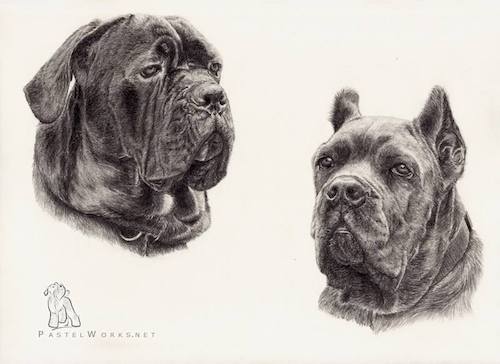
The Cane Corso descended from Roman war dogs known as ‘Canis Pugnax,’ and technically, it belongs to a subcategory of working breeds called mollosers. These dogs were so named after an ancient Greek tribe, the Molossi, who were thought to have bred huge Mastiff type dogs. The name itself, ‘Cane Corso,’ comes from the Italian ‘cane,’ meaning dog and ‘cohors‘ meaning guardian or protector. The plural form of ‘Cane Corso,’ by the way, is ‘Cani Corsi,’ not ‘Cane Corsi.’
Though the breed is an ancient one, the Cane Corso only first came to America in 1988 when Michael Sottile (a Neapolitan Mastiff breeder) imported a litter from Italy, and this only after breed enthusiasts in Italy revived the nearly extinct breed in the late 1970s, and formed the Society Amorati Cane Corso (Society of Cane Corso Lovers) in 1983. Sottile imported several dogs more dogs in 1989 and created an American standard for the Cane Corso, while at the same time becoming the first official US delegate to the Society Amatori Cane Corso (SACC). At the time Sottile imported the dogs, they were known as Sicilian Branchieros, the name changing to Cane Corso some time between 1988 and 1990.
The Italian Kennel Club didn’t officially recognize their native breed until 1994, possibly because the breed was known only in Southern Italy, and even then was considered rare. Indeed, only in 1957 when Professor Giovanni Bonatti published an article mentioning the need to save the Cane Corso did its predicament become better known.
For the individual who has their head “in the right place, this is an amazing dog,” but it’s important to be mindful of something the Cane Corso Association of America has written on its website. To paraphrase, “A dog’s breed doesn’t make one look more manly.” An attraction to this breed’s appearance as the sole purpose in owning a Cane Corso is the worst of reasons to have one. These are intensely loyal, protective, sensitive and serious dogs who, as adults, can weigh 110 pounds; early socialization and responsible training is not an option. Again, as the club says, “Dogs do not believe in social equality,” and thus, an owner who lacks leadership and a self-assertive personality is a poor fit for the breed. Why? Because these dogs have been described as having majestic personalities and deserve owners whose own temperaments aren’t overwhelmed by a dog’s.
Image: Cane Corso in pencil by Tobiasz Stefaniak
www.pastelworks.net Pet Portraits

We had a Cane Corso in the 1960’s. One of our neighbors brought them over from Italy and had a litter. There were 13 pups and we wound up with one that was a day old. Mr. Merino didn’t think the mother was going to be able to feed all 13 so we were lucky enough to get one. My Mom fed our pup with an eye dropper every 2 hours, then my doll bottles were used and finally baby bottles. Our Dolci lived to be 14 years old. So there was a corso here before 1988. I am not the only one that has had one before 1988. I’ve talked to a few people and when you tell someone this they tend not to believe me. But we have pictures to prove it. Since then I’ve had two more and just love the breed. Our Gabriella crossed over the Rainbow Bridge April 22, 2019.
Amalia, we’d be delighted to update our information with your story and pictures! Contact us again armed with a photo or two, let’s update this information!
Personally I think the Briard is the most majestic breed.
I added a picture of my Briard named Bojangles.
We can’t disagree, Ian, and Bojangles is wonderful, thank you for sharing his picture!